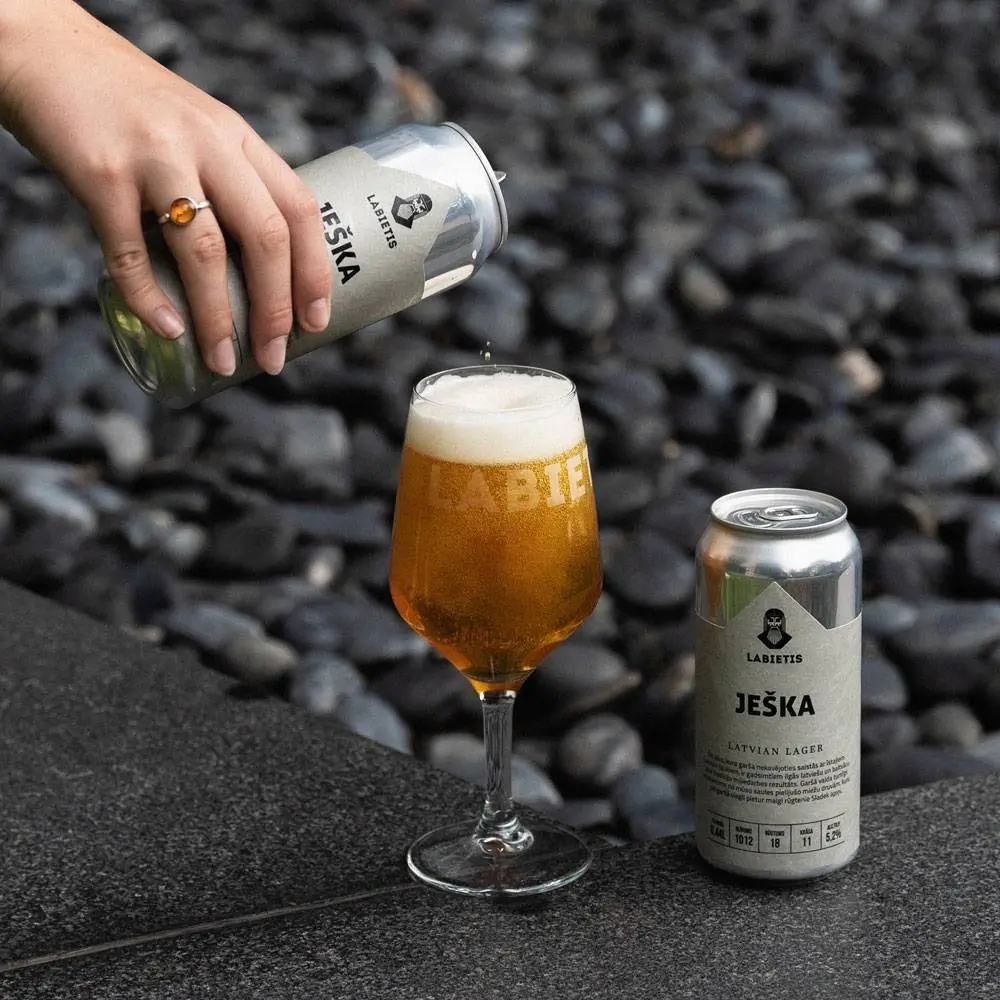ALE or Lager? | A general introduction of types of beer
"We only have the ales."
"But I want a beer!"
Continuing on the topic of foreign words, let's briefly and concretely distinguish between ale and lager.

Some of the pub's tourists are still in solemn awe when they hear that Labietis only brews ale or craft beer. That charming word that rolls off the tongue - "eils". It makes you expect something unusual to happen immediately. Something that has come from the legends of the Round Table and the cloudy London.
Others have a look of undisguised disgust on their face. Ales? What Ales?! They have come for a refreshing hoppy brew, not the slick British Isles booze - ale. Those English can't brew beer properly!
In fact, both complicate life unnecessarily! Both ale and lager are beer. Both can be bitter, sweet, dry or sour (as well as all the other adjectives), depending on the ingredients and the skill of the brewer. The only and main difference is the yeast strain used, Saccharomyces cerevisiae or Saccharomyces Uvarum (known as Saccharomyces Carlsbergensis before scientists tasted Carslberg and decided to cut all ties with the term). These long Latin words also give rise to all the different characteristics.
Hot vs cold - the role of temperature in the taste of beer
The main difference between ale and lager is the fermentation temperature.
Ale operates at room temperature between 12 and 20 degrees (when fermenting saison-type beers, the temperature can rise to 30 degrees, creating defects that the Belgians christened as traditional flavours). At this temperature, more oils and esters are released, creating a 'wide' bouquet of flavours. This is why the first sips can seem intense, even overdone, to an inexperienced ale drinker.
Lager came later, when innovative cellar-digging technologies allowed experimentation with fermentation at lower temperatures (between 7 and 12 degrees). Low temperatures helped to produce a 'cleaner' beer, lighter in flavour and crisper in the mouthfeel.
There is no right or wrong answer to this question. It's like comparing whether Cielaviņa is better than Vāverīte wafer cake. Both are desserts, both count as cakes, but they satisfy very different tastes.
It all started with ALE.
People have been drinking ales since the ancient Proto-Aldarians (proto - before) accidentally infected the wort with yeast and started the millennia-old brewing culture. Ancient Egypt, the Two Rivers, the Chinese Empire - every civilization worth talking about brewed beer, and the only brewer's yeast that could ferment wort before ice cellars was ale. To talk about the history of ales is to talk about the history of all brewing up to the 16th century Bavaria, when the first lager-like brews appeared.
Ale is beer in its most traditional and ancient form. In marketing parlance, an ale is the real-original-traditional-ancient beer. The whole world, including the Czech Republic and Germany, drank ales until Bavarian purity began to limp.
How the German Dukes regulated the Lager
Despite German precision, the 16th century Bavaria suffered from a nasty problem: summer ales often tasted sour and otherwise defective. Flavour-tasting bacteria broke inside the open fermentation tanks, spoiling the beer. Brewers tried to remedy the situation in true craft beer tradition with sawdust, soda water, cattle bile and even chicken blood, but the ales still tasted strange.
This lack of quality visibly spoiled the Bavarian court shish kebab parties and boys' nights out. Unlike the Belgian summer workers (saison) The Bavarian patricians didn't want to tolerate the taste of summer beer. The presence of chicken blood was also frankly hilarious, so in 1487, Duke Albert IV of Bavaria publicly ordered his brewers to give up experimenting with animal liquors and use only hops, water, yeast and malt (this later led to the notorious German Beer Purity Law in 1516).
Despite food and veterinary safety regulations, the beer was still sour and tasted unacceptable to the German nobleman. For almost a hundred years, wise heads complained, punished and regulated, but the beer didn't get any better. Only Duke Albert V showed some character, caved in and decreed that Bavarian brewers would no longer brew beer in summer. If it doesn't work, don't! The court applauded, but the brewers scratched behind their ears and wondered what to do. Just as the Belgians made summer beer blemishes a traditional taste, German brewers embraced the new fashion as an important element of brewing culture.
From now on, Bavarian brewers only brewed beer from autumn to spring. The desire to drink beer all year round led brewers to think about maturation, which developed the use of ice cellars and mountain caves for storing beer. Longer storage also meant that beers usually contained a moderate level of alcohol (6-7%). In summary, this process was christened 'lagerisation' from the German word“lagern” ('keep'). This brewing made the beer taste "cleaner" and allowed the yeast to settle neatly at the bottom of the barrel - making the beer clear and light. But this was not lager as we know it today!
The Bavarians did not brew the traditional golden-luxe-premium lager, it was rather dunkel - a bronze-coloured beer with distinctly caramelised notes, still based on a type of ale yeast.
The lager came from afar.
The strangers - the arrival of the modern lager
Despite the marketing material for consumer beers, lager does not come from the family brewery, the Czech Republic or Bavaria. Scientists believe that lager yeast - Saccharomyces Eubayanus was born in Patagonia, South America - 11 000 kilometres from the Bavarian mountains. Researchers have discovered that this yeast has a 99.5% match with the non-eagle parts of the Bavarian yeast. A more similar yeast variety has still not been found in the wild.
It is not clear exactly how the yeast travelled to Bavaria to mate with local strains, but transatlantic shipping certainly helped - the yeast was able to settle in fruit, fermented drinks, the oesophagus of flies and even wood.
This modern breed of lager was able to live comfortably at low temperatures, so that in 1894. In Munich (together with British freezing technology), the first extra-ancient lager was created. Munich's hippest local Spaten started a new Helles the trend for lighter, fresher and crisper beers than their amber contemporaries.
California wants its own beer!
Experiments with temperatures don't end with the development of the Lager. Once a stable variety of lager yeast was established, there were craftsmen who found the rules a challenge. When 19th century American brewers heard that lager fermented at temperatures of up to 12 degrees, they pioneered the spirit of boiling beer, adding lager yeast and stubbornly leaving it in the heat.
When German colleagues objected, "Aber das ist kein lager! " (German: "Eu, Jacks, you're brewing our beer wrong!"). The Americans replied with something about freedom, penis size and a tank full of hops.
The result was Steam Beer – a special variety of American lager, distinguished by its strongly hoppy flavour and the pungent yeast ester that comes from lager yeast working faster.
Of course, until Anchor Brewing Co. bought the copyright to the term "Steam Beer" in a very American way, turning it into California Common.
ALE
- Top-fermentation (yeast produces a protein layer and mostly thaws at the surface)
- 12 - 20 degrees (with exceptions >30)
- Ales have been used in brewing for the longest time, from the beginnings of fermentation to the present day.
Lager
- Low fermentation (yeast settles at the bottom of the tank)
- Temp. 7 - 12
- First experiments ~15th century, widespread use in the 19th century
- Flavours: crisp, light.
REFERENCES:
http://allaboutbeer.com/article/munich-helles-5/
https://www.history.com/news/lager-patagonian-for-beer
http://www.beer-faq.com/steam-beer/




